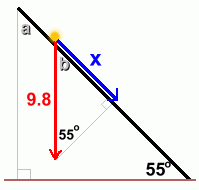|
The force of gravity that pulls you downwards towards the centre of the earth would cause you to accelerate if the ground weren't in the way. This means your speed would increase, with every second that passes. The value of the acceleration due to gravity is 9.8 m/s2, or 9.8 metres per second per second. In other words, as you fall, your speed will increase by 9.8 m/s for every second that you fall. Designers slow the acceleration by making a ramp. The angle of the ramp determines what the acceleration will be ... the larger the angle, the closer the value will be to 9.8 m/s2 You can actually calculate the acceleration down the ramp by using some trigonometry. This calculation comes from Math 9 and Math 10C; the topic of acceleration vectors itself is from Physics 20. However, the ramp causes you to fall at an angle. The ramp's angle is 55°, which results in an acceleration doen the ramp of only 8.0 m/s2 The length of the ramp is then designed to give the desired (and safe) final speed at the bottom. The question now is where did the 8.0 come from. Let's look at the calculation: Examine this diagram closely.
 Using a simple trigonometric function, the sine, we can calculate the value of X. It turns out to be 8.0 |
